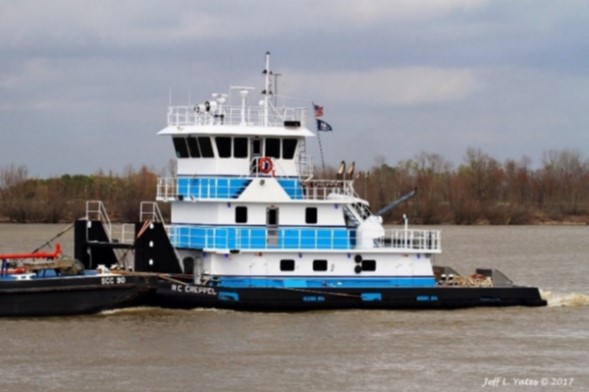NTSB: collision leading to loss of life and damage
The National Transportation Safety Board of the United States (NTSB) has published Marine Accident Brief 21/16 relating to a collision on the Mississippi river in January 2020. The collision led to damage and loss of life, and learnings from the causes of the collision are applicable to the operations of IMCA members.
What happened
One towing vessel was moving 40 barges upriver, and another was moving two barges downriver, when they collided. As a result, one of the towing vessels capsized. Minutes later, a third vessel going upriver made contact with the some of the barges being towed. All 42 barges from both tows broke free and were later recovered.

One of the four members of the crew of the capsized vessel was rescued; the remaining three were never recovered and are presumed dead. The accident resulted in the release of about 8,000 gallons (US) of diesel fuel into the river and sulphuric acid vapours into the atmosphere, and property damage to three vessels and 11 barges, costing an estimated US$3.8 million.
What was the cause?
The NTSB’s investigation found that the probable causes of the collision were (IMCA bold for emphasis):
- The two pilots’ insufficient radio communication before meeting in a bend of the river;
- Not broadcasting accurate AIS information regarding tow size.
Lessons learned
- Ensuring adequate communications – whilst this incident is about communications as an aspect of seamanship, the same principles apply to communications between:
- Shifts at shift change time;
- Crews at crew handover time;
- Departments within the vessel – bridge team, lifting personnel etc.,
- Departments within a company – project, crewing, human resources, engineering etc.,
- Client and contractor, and contractor and sub-contractor.
- Up to date information – ensuring that all appropriate and up to date information is available to all stakeholders, is likewise a lesson applicable not only to the bridge operation but to all. To do so helps to alleviate possible misinterpretation and enhances situational awareness.
Members may wish to refer to:
- Yawing of wind turbine nacelle placed ship in line of fire [causes: Lack of situational awareness; Failure to follow established communication protocols.]
- Lifting complex loads – offloading third party equipment [what went wrong: Inadequate handover, inadequate communication, inadequate information]
- Damage and engine room flooding following contact by tugboat [causal factors: ineffective information exchange and communication, inadequate supervision]
- USCG: Automatic identification system (AIS) inaccuracies led to fatalities [This accident, reported earlier]
Safety Event
Published: 1 October 2021
Download: IMCA SF 27/21
IMCA Safety Flashes
Submit a Report
IMCA Safety Flashes summarise key safety matters and incidents, allowing lessons to be more easily learnt for the benefit of all. The effectiveness of the IMCA Safety Flash system depends on Members sharing information and so avoiding repeat incidents. Please consider adding [email protected] to your internal distribution list for safety alerts or manually submitting information on incidents you consider may be relevant. All information is anonymised or sanitised, as appropriate.
IMCA’s store terms and conditions (https://www.imca-int.com/legal-notices/terms/) apply to all downloads from IMCA’s website, including this document.
IMCA makes every effort to ensure the accuracy and reliability of the data contained in the documents it publishes, but IMCA shall not be liable for any guidance and/or recommendation and/or statement herein contained. The information contained in this document does not fulfil or replace any individual’s or Member's legal, regulatory or other duties or obligations in respect of their operations. Individuals and Members remain solely responsible for the safe, lawful and proper conduct of their operations.
